Briefly Talk About The Basic Knowledge Of Terminal Blocks And Key Indicators For Selection
Cable Lugs is to make reliable mechanical and electrical connections to wires. This function can be effectively achieved by using the voltage wire frame of the terminal. The press frame is made of hardened and galvanized passivated steel. Steel screws that can withstand large torque can firmly press the wire. The surface of the copper sheet is plated with a layer of flexible tin-lead alloy to ensure airtightness, low resistance and permanent connection with the wire.
The following points are deeply loved by users and widely adopted:
1) The contact surface is large, and the contact social pressure is large, and any lateral contact can be made.
2) It has self-locking, shock-resistant and anti-loosening functions.
3) The test jack can be installed without maintenance.
4) Absolute air density and corrosion resistance at the contact point.
5) Multi-strand wires can be directly connected without crimping the end.
6) Easy to use.
7) Widely studied and adopted by students worldwide with large contact pressure
In the terminal, contact force is one of its basic elements. If there is not enough contact pressure, it is useless to use good conductive materials. Because, if the contact force is too low, displacement between the wire and the conductive sheet will occur, resulting in oxidation pollution, increasing the contact resistance and causing overheating. Taking the DRTB2.5 compression wire frame assembly as an example, only applying 0.8Nm of torque to the screw can generate an actual contact force of up to 750N, and the size of this contact force is independent of the wire segment. Therefore, the use of terminal voltage wire frames has a permanent connection without any environmental influence, a large contact area and a large contact force. Small voltage drop The voltage drop at the contact point is also one of the levels for identifying the quality of the junction. Due to the small force distance on the screw, the voltage drop is still far below the limit required by VDE0611. At the same time, the applied torque varies over a wide range, and the voltage drop is almost constant. Therefore, although different operators use different torques, they do not affect the quality of the connection. This is another proof of the reliability of the terminal. The contact force with a large self-locking function is only meaningful when it acts continuously on the wire.
The use of pressure wire frames for connecting terminals also has absolute reliability in this regard. During the tightening of the screw, the threaded tongue on the pressure wire frame bounces up, thereby generating a reaction force against the screw. Since the change in wire diameter caused by temperature is offset by the elastic effect of the crimped wire frame itself, it is not necessary to tighten the screws again. The wire frame pressed on the wire is subjected to an aging test for 168 hours at 130°C and then a vibration test for 168 hours at 20 times the acceleration of gravity. After these tests, which are more severe than VDE0611, the pull-out force of the wire from the crimping frame is still six times greater than the force specified in VDE0611, and the voltage drop remains unchanged. This clearly shows the maintenance-free performance of the terminal using the voltage wire frame. Airtightness is a number of environmental factors that have affected the terminal for many years, such as temperature, air humidity, etc., so the terminal must be able to withstand the test of adverse environmental factors. Tests and practical experience conducted in accordance with the provisions of Chapter 76 of DIN 41640 have proved that the airtightness of the terminal can be maintained even if the terminal is not crimped when connecting soft wires.

